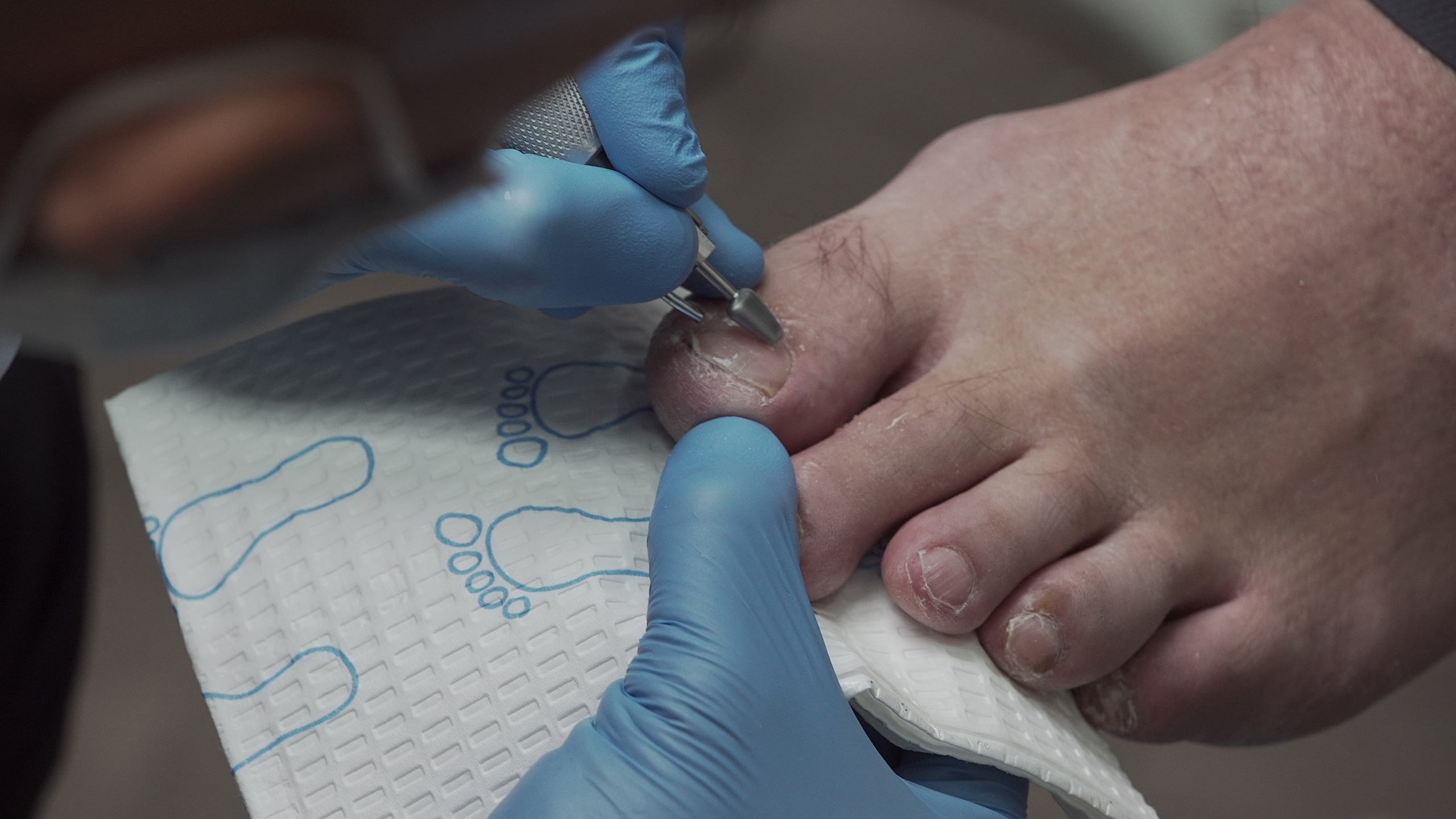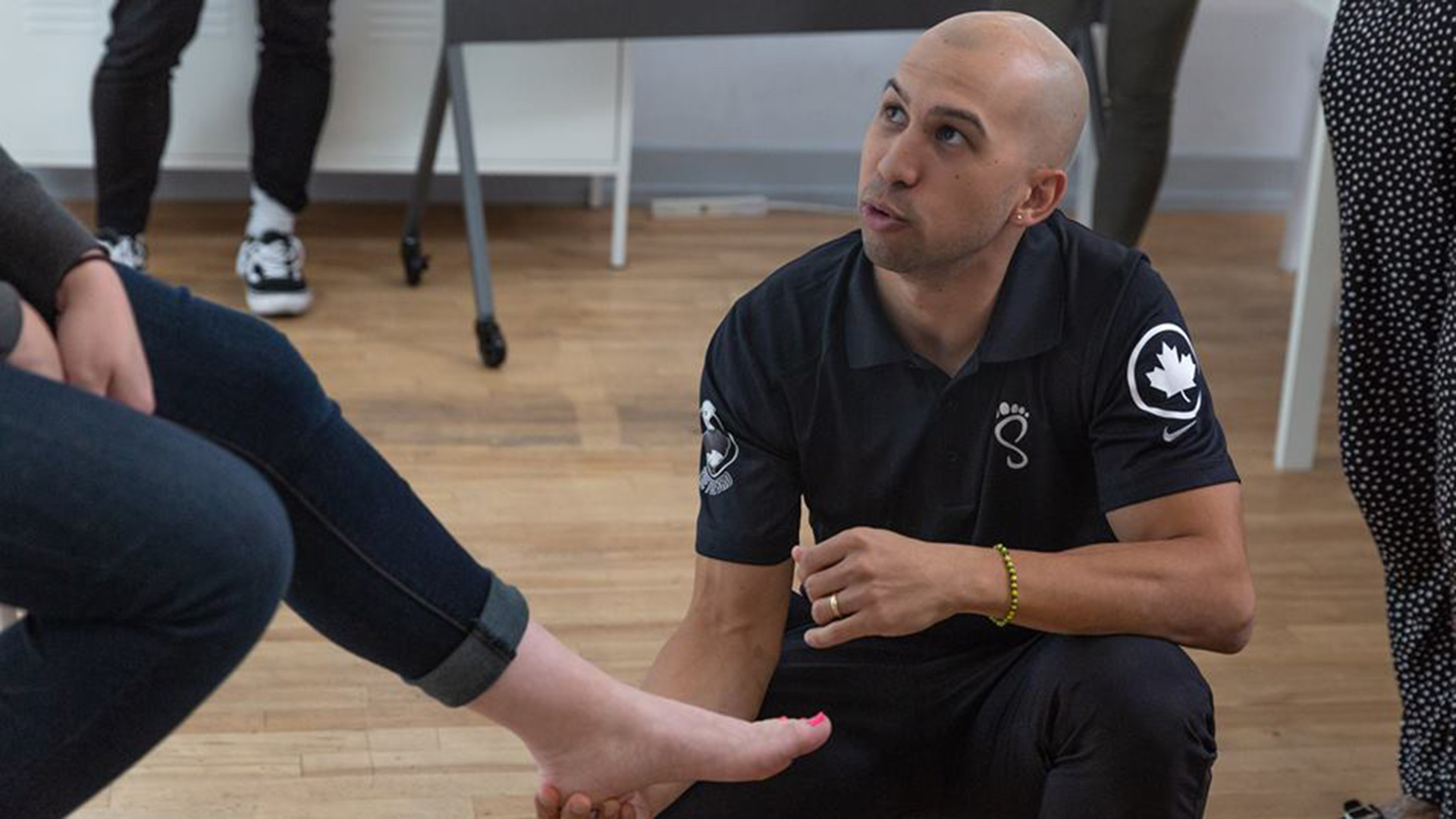Ingrown toenails, cracked heels, bunions, plantar warts. Jonathan Tomines, also known as "The Toe Bro," has seen it all—and then some.
As a chiropodist—which is different than a podiatrist in that a chiropodist can't do any bone surgery—Tomines went into his profession to help people with their embarrassing foot issues. Plus, feet were in the family: His dad was also a chiropodist. He soon learned that even though some people cringe when seeing anything to do with tootsies, there are also a lot of people interested in learning more about gnarly foot issues and how they're treated. Tomines' YouTube Channel has over 380,000 subscribers. "Feet are so relatable," he says.
Tomines, of the A&E show, The Toe Bro, spoke with us about one of his craziest cases, how his dad once made him treat his own foot issue and what he thinks of nail salons and flip-flops.
Can you tell us a little bit about one of your craziest cases?
A barber stepped on a piece of glass; he tried to find it [in his foot] and couldn't. He went to the hospital, got an X-ray and they found it, but they said it would come out on its own—that his body would push it out. But it healed over. So he's stepping on this piece of glass every day.
He went back to his family doctor. They took another X-ray and they sent his referral to six different orthopedic surgeons. No one really wanted to deal with it. Eight months later, he comes in the office. I saw the X-ray, numbed his toe and pulled the piece out.
Have you ever had any major foot issues yourself?
Yes, I'll never forget. When I was in university, I started going to the gym. I guess I didn't learn anything from my dad at that point, because I was walking around barefoot in the changing room and the showers. I got three big plantar warts [on my foot] and I didn't know what to do. I asked my dad and he made me a felt pad with holes right over the warts. He gave me a strong salicylic acid and a scalpel.
[The treatment is you] put the acid on them and cut them out. I literally had to dig these warts out myself for three months…with his guidance, but it was painful. It was three to four months of walking around with craters on my foot.
But now when you see patients with plantar warts, you know exactly what they're going through.
Yes. I'm a clinical instructor, and I let all the students numb my toe with an injection so I can see their technique. But it's on the condition that I get to freeze their toe.
It's really important for me to know what [patients] go through…so I can be a little more empathetic. I [have also] zapped myself with a laser I use to treat warts.
When you first started practicing, did you ever have a major physical reaction when handling a really bad case?
The biggest thing when I first started practicing [was] seeing an infected ingrown [toenail] for the first time. [It was] just overwhelming. The moment someone takes off their sock, or shoe, you can already smell the pus.
And sometimes a toe becomes so swollen…or the toe is just deformed. and you're just like, 'What the heck am I going to do?' But, you learn to stay calm and get through it.
So since those first cases, you've kind of been able to control your reaction a little bit?
Nothing phases me. I put on a good poker face. A lot of stuff smells really bad, but I will never say that. I never tell the patient, 'This is gross.' I try to make them feel as comfortable as I can.
Is there a level of personal satisfaction when you've removed an ingrown toenail? Because it looks like you enjoy the removal process.
I don't get pleasure out of it. I get pleasure seeing the person looking at their foot [afterward]. Or just seeing them, knowing that they're having the issue [treated]. That's what makes me feel good. The satisfaction that they're going to have this problem solved. They're going to feel better about their feet.
I'm sure it's going to come up, but I do not have a foot fetish. This is something that I get asked all the time. People with a foot fetish like a certain type of feet. The feet I see are not [in the best condition].
Why do you think there's such an interest in wanting to watch other people’s graphic foot procedures?
Feet are so relatable. Most people have feet, toenails. We have skin, and all these problems can happen to any one of us. People are fascinated [when they see foot conditions], and think, 'Wow, how did that happen?' or 'That happened to me,' or 'This could happen to my foot.' They're engaged because they're worried about their own feet.
And feet are so personal. It's hard to explain, but feet are sacred; [some people] don't want to show off their feet. A lot of people suffer from foot pain and they don't want to say anything. But seeing someone else go through it, it's kind of almost therapy for them. Or [watching someone else go through a procedure] helps by giving them advice and tips to help with their own feet.
Are some people predisposed to certain foot conditions?
For sure. Some people are born with poor foot structure, bunions, clawed toes. Some people are born with really curved, ingrown toenails or thickened toenails. Some people are born with excessive skin growth on the bottom of their foot, so it looks like they have thick calluses, like they're wearing a rubber shoe.
For people who aren't predisposed to those kinds of conditions, are there certain things they do that cause them to have to eventually have to see a foot specialist?
Eighty percent of all foot problems happen from poor footwear: whether it's too tight, too narrow, too shallow, not enough padding, doesn't fit your foot properly or using the wrong shoe for the wrong activity. These things will cause ingrown toenails, thickened toenails, bunions, claw toes, foot pain, heel pain, ankle pain, blisters, callus, corns, pretty much everything.
How could a tight shoe cause a major issue?
If you wear a shoe that's too tight, your toes are going to curl. And if you leave your toes curled for a couple of months—people use poor shoes for years—then they will become stuck like that.
But sometimes people buy a pair of shoes they later realize is uncomfortable but figure they'll wear them a few times and eventually they will become comfortable. So is 'breaking them in' not a thing you recommend?
Not a thing. I always say, 'If the shoe doesn't fit, it's not for you. You're not Cinderella.' I always think of that story, of all those women trying to stuff their feet in that glass slipper. It's not going to work.
In terms of bad footwear, is it true that flip-flops, in particular, are really bad for your feet?
Not necessarily. If you have a strong foot, if you can handle wearing something that has very little support, then you're okay. But most people don't have strong feet, because they aren't using them enough. The muscles in their feet aren't ready to be walking around relatively barefoot. That's why a flip-flop is bad for them.
But, if the flip-flop has a little bit of support— more straps to hold the foot to the padding—then it's a little bit better. If the shoe is a little bit thicker and softer, and gives you more cushioning, that's a little bit better as well.
And there's different styles. If you're wearing a flip-flop wedge that's hard like a rock, that's not going to be very good. If the foot is very unstable on that flip-flop, then the toes start to grip the ground, or if there's no support, the foot starts to fall in, which can cause muscle pain and discomfort. So they aren't bad if your foot can handle it. But most people aren't prepared for flip-flop season.
The worst is wearing flip-flops in the rain. Then your feet have to work hard to keep the flip-flop from floating away.
Right. And now you're using all these muscles that weren't ready for that. Then they get sore, now you can't walk. And the reason why foot pain is so hard to treat is because we're always using our feet. Our feet never get a break. They don't get to rest. It's why feet get beat up pretty bad.
For many people, nail salons are the go-to place to take care of their feet—even going to them for basic foot procedures, like removal of a small ingrown toenail or callus. Do you have any concerns with this?
In my profession, most people don't look highly on nail salons. But [nail salons] see a lot of feet. A lot of [salon workers] have a lot of skill. The issue is whether their space is clean, if their instruments are sterilized and that person's technique. If they're using a blade, do they know how to use that blade properly? [If not] that could be dangerous. Or if they're cutting an ingrown nail out, and the tools aren't sterilized, and they cut the skin, now you've got an infection. That's my big concern.
But if they have great technique, if they have a good, clean working space and clean instruments, I don't have a problem with them.
What about those salons that have the fish eating dead skin off the bottom of your feet?
I think about all that water that the fish are sharing [that's mixed with] whatever they picked off of another person's foot. It's just kind of gross.



